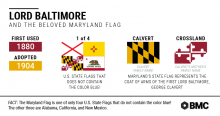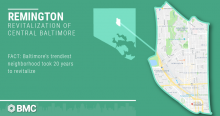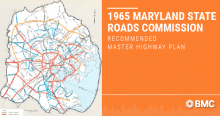You’d be hard-pressed to go anywhere in Maryland without seeing proud residents sporting the arms of the Calvert and Crossland families, which are emblazoned on the state flag, and apparel ranging from sunglasses to socks. Maybe the flag’s popularity is because of its bright colors, busy design, or simply brilliant marketing by the state’s Tourism Board. But we’d like to think that the flag’s popularity has to do with its post-Civil War rebranding, which was intended to reconcile, quite literally, warring neighbors. Either way, its colors and patterns are rooted in the inception of Maryland’s colonial charter, which marks its 386th anniversary on Wednesday, June 20. For the occasion, we dug into our archives to present a brief history of the western world’s founding of the colony of Maryland and it’s appeal to His Royal Highness Charles I, King of England. Hint: The appeal is expansion and trade. Before European subjugation, there is evidence of inhabitants in the area dating back to the ice age. Captain John Smith - yes, the John Smith from the Disney movie - explored the upper Chesapeake in the early 1600s, and encountered many indigenous American Indians. Algonquin tribes claimed most of the land, although both Iroquois and Sioux also maintained a presence. As a result of his exploration, Smith couldn’t help but go on and on about how in awe he was over the beauty of the upper Chesapeake. We’ve hiked along the Patapsco River on a nice fall day, so we totally get the appeal, John. In fact, that’s the reason that William Claiborne, the pioneer and surveyor, first traveled to Virginia and then established a trading post on Kent Island in what’s now Queen Anne’s County. Once trade was established, the nobility and legality followed. George Calvert, the first Lord of Baltimore, explored the Potomac River and Chesapeake Bay, following stints in Newfoundland and Virginia. Calvert originally asked the king for permission to colonize the land south of Virginia, but was met with objections from its people. The king ultimately granted Calvert the land north of Virginia, but he died during the preparation of Maryland’s charter. So the land went to his heir, Cecil Calvert, the second Lord Baltimore. Once the charter’s ink was dry, King Charles I, named the new colony after his wife Queen Henrietta Marie using the name “Terra Mariae,” which means Mary Land. On November 22, 1633, Cecil Calvert set sail for this new colony in two ships - the Ark and the Dove. The ships arrived at the mouth of the Chesapeake at Old Point Comfort three months later, and sailed north to St. Clements Island before negotiating and purchasing land that they named St. Mary’s. At the end of May 1934, the Ark returned to England, leaving the Dove behind to provide transportation for goods – ranging from corn to cod - to be traded up and down the Atlantic seacoast. In August 1635, the Dove sailed back to England with furs and timber to trade, but was never seen again. The Calvert heritage can be seen on both the state seal and state flag. The Calvert colors of gold and black appear opposite the red and white colors of the Crossland family that was the family of the mother of George Calvert. So the next time that you see Maryland’s flag on tank tops or swim trunks, you’ll understand their long history. Sources: Maryland: The Seventh State, A History (Third Edition) – Author: John T. Marck – Creative Impressions, Ltd. 1995 Exploring Maryland’s Roots - http://mdroots.thinkport.org/library/kingqueen.asp Historic St. Mary’s City - https://hsmcdigshistory.org/research/maritime-curation/ark-and-dove/ Maryland Manual Online - https://msa.maryland.gov/msa/mdmanual/01glance/html/symbols/seal.html Maryland Manual Online - https://msa.maryland.gov/msa/mdmanual/01glance/html/symbols/flag.html
Twenty years ago, Remington faced more than a decade of population decline (8.97 percent), 2.52 percent higher than Baltimore City at the time, which the region’s stakeholders assessed negatively affected the neighborhood’s stability. On Saturday, May 12, hundreds of people milled about through a two-block area - between the newly developed and trendy mixed spaces of Remington Row and R. House - to eat, drink and listen to live music on a hot spring day. It wasn’t an event exclusively for Johns Hopkins University students, nor a give-away at Charm City Cakes. RemFest 2018, Remington’s inaugural outdoor festival, was the announcement that this is a neighborhood on the rise.On Saturday, May 12, hundreds of people milled about through a two-block area - between the newly developed and trendy mixed spaces of Remington Row and R. House - to eat, drink and listen to live music on a hot spring day. It wasn’t an event exclusively for Johns Hopkins University students, nor a give-away at Charm City Cakes. RemFest 2018, Remington’s inaugural outdoor festival, was the announcement that this is a neighborhood on the rise. But Remington’s revitalization story is a success because of its various public-private partnerships throughout the last 20 years. Residents, businesses, universities, nonprofits and the state have worked together to provide grant funding and mutually beneficial business deals to bolster these efforts and serve as a model for the Baltimore region. We dug into the Regional Information Center’s archives to read Remington’s 1998 Community Mini-Profile, one of a series that highlighted statistics in specific areas of Baltimore City, to compare it to the neighborhood’s recent renaissance. The report, prepared by the Community Development Resource Center at the Institute for Urban Research at Morgan State University, examines seven key aspects of the Remington community: population, households and families, housing, health, education, income and public assistance, and crime. The intent of the report was to assess the needs of the Remington community, but also to use it as a marketing tool to assist in the revitalization of blighted parts of the neighborhood. So let’s rewind.The demographic breakdown of Remington in 1998 was 81 percent white and 13 percent black, with 25.37 percent of residents less than 19 years old, and 22.39 percent seniors. The teen pregnancy rate (10.20 percent) was 2 percent higher than Baltimore City’s, and cancer and heart attack/stroke were the main causes of death at 35 and 31.67 percent, respectively.These demographics suggested the need for day care services, education and recreation programming, as well as medical services and alternative living arrangements. It’s encouraging to see some of these assets realized, specifically through the 2017 completion of Remington Row, one of several Central Baltimore projects by Seawall Development, includes both physicians’ offices (for children, women’s health and internal medicine), a drug store and more than 100 affordable apartments. Speaking of housing, the Remington of 1998 included 1,199 units, with 91.49 percent total occupancy and 55.52 percent owner-occupied properties, according to the report.In 1997, the Johns Hopkins University’s Live Near Your Work employer-assisted home-buying program partnered with the state to offer cash grants between $2,500 and $17,000, according to Baltimore City’s 2012 Maryland Sustainable Communities application. The intent was to help employees buy homes in targeted areas around JHU’s Homewood and medical campuses, which many have done since then, therefore increasing owner-occupancy in the neighborhood and providing it with greater stability.Finally, Remington’s 1998 household income was $22,981, with utilization of public assistance services 26 percent below Baltimore City’s at the time. Today, organizations such as the Central Baltimore Partnership, Remington Neighborhood Alliance, Greater Remington Improvement Association, Charles Village Community Benefits District, Historic Fawcett Community Association and Healthy Neighborhoods work together to advocate on behalf of the community, organize and plan, then apply for grants to improve workforce development and transportation access for residents.Twenty years ago, Remington, a neighborhood of row houses and old factories, was on the decline. But the community has come together to create a place where people want to live, work, shop and raise families.Remington is both an example of the type of transformative revitalization that can be replicated across Baltimore as well as a reminder that real community change takes time, planning and partnership. Sources:Community Mini-Profile Series 1998 No. 02 (Spring Edition): Remington, prepared by the Community Development Resource Center, Institute for Urban Research, Morgan State University, Spring 1998
Flowers, brunches and greeting cards full of loving messages are just a few of the ways that we celebrated the mothers in our lives on Sunday, May 13. Thanks for all that you do, moms - you’re awesome! Those packed brunch spots and ransacked floral departments at our local grocery stores caused us to pause and think though - there are a lot of mothers in the Baltimore region, and a lot of mothers mean that there have been a lot of births. So we dug into some data from the Maryland Department of Health and Mental Hygiene and examined the birth rate* in each of the Baltimore region’s seven jurisdictions and the state from 1965 through 2016. What we found was that the Baltimore region’s birth rate is at its lowest point in more than 50 years. This information shouldn’t be surprising, given the increase in females in the workforce, increased use of contraception and cost of living during the last 50 years. In 1965, the Baltimore region’s birth rate was 20.3, while the state’s was 20.9. In 2016, both rates were 12.1. As we continued to analyze the data, we saw that while slightly lower, the region’s birth rate is very similar to that of the state over time. What is notable is when the birth rate takes a sudden hit. Both annual births and birth rates in the Baltimore region declined from the beginning of Generation X in 1965 through the mid-1970s. But then the average birth rate declined drastically from 14.0 in 1972 to 12.6 in 1976. In Queen Anne’s County, the birth rate dropped as low as 9.9 in 1974. What’s interesting about this four-year period is that the birth rate dropped just as the U.S. felt the effects of the 1973 oil crisis and economic recession. It then slowly increased to 13.4 in 1977, and continued to steadily climb through 1990. Baltimore City, in particular, saw its birth rate peak at 19.5, or 2.8 points above the region’s average, in 1990. A similar pattern emerged as the U.S. dipped into the Great Recession after the 2007 subprime mortgage crisis. In the Baltimore region, the average birth rate was 13.5 in 2008, before dropping to 12.9 in 2009. However, Carroll County’s birth rate hovered between 9.2 and 9.6 from 2009 to 2014. So while the Baltimore region’s birth rate remains 1.67 times lower than 50 years ago, a dip in the economy could send it slightly further south. Can we please agree to continue buying those flowers, brunches and greeting cards to do our part in keeping the economy strong? *The birth rate is calculated at the number of births per 1,000 people. Sources: Maryland Department of Health and Mental Hygiene https://www.cia.gov/library/publications/the-world-factbook/rankorder/2054rank.html
Motorists driving through the Baltimore region may notice several ramps to nowhere along I-95 as they travel into or out of Baltimore City. Once upon a time, these structures were part of a massive regional highway plan.We dug into the archives at the Regional Information Center (RIC) and found the 1965 Maryland State Roads Commission Recommended Master Highway Plan. The document was a grand proposal for I-70 - the major highway that begins in the Baltimore City neighborhood of Franklintown and runs east-west through Maryland to Breezewood, Pa. As put forth more than five decades ago, this highway would have extended to meet I-95 in Baltimore City’s central business district. Problems with traffic congestion and flow already were in full swing in the early 1960s in the Baltimore region. The plan projects growth of more than 2.6 million residents and more than 700,000 vehicles by 1980. This was a tall order for the region’s road network. So as the U.S. Department of Transportation constructed I-95 north and south through central Maryland, the Recommended Master Highway Plan was the solution. The ramps were built, but the I-70 connection never came to fruition. Nor did the construction of the proposed I-83 route through Central and South Baltimore, for that matter. I-70 was scheduled to go straight through the Baltimore City neighborhoods of Fells Point and Canton, while many of the planned higher-occupancy roadways ran through historically low-income and African-American neighborhoods. That’s why community activists, such as Barbara Mikulski, then a fresh graduate of the University of Maryland’s School of Social Work and east Baltimore native, organized city residents from east to west to stop the projects in their tracks. Source: Baltimore Metropolitan Area Transportation Study. Master Highway Plan




